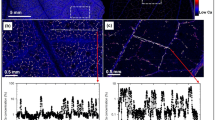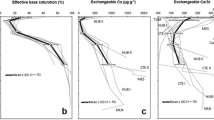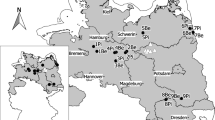Abstract
Calcium (Ca) is an essential macronutrient which plays a fundamental role in ecosystem structure and function. In temperate forest ecosystems, Ca oxalate is ubiquitous, existing in live and decomposing biomass pools. Calcium in minerals occurs principally as carbonate and silicate. Because of structural differences between its different forms, Ca speciation can influence the Ca biogeochemical cycle. In this study, we compared three beech temperate forests of contrasting soil Ca availability, i.e., dystric cambisol (DC), eutric cambisol, and rendzic leptosol (RL), but with similar climates, atmospheric depositions, species compositions and management. The pools and fluxes of total Ca (Cat) and Ca oxalate (Caox) were assessed in plant samples (aboveground and belowground tree tissues, forest floor). Pools and fluxes of Cat were also quantified in the atmospheric inputs (dry and wet deposits), in the soil (total and exchangeable fractions) and in the soil solutions at different depths. The soil solutions were measured monthly for 4 years to study the seasonal dynamics of Ca fluxes. A budget of dissolved Ca was also determined for the forest floor and soil layers. Regarding the global Ca cycle at the stand scale, our study highlighted: (i) the predominant role of biological recycling in the Ca cycle in forest ecosystems for all soil types; the turnover rates of fine roots and leaves were approximately 43 and 39% of the total Ca taken up by trees each year, revealing that only 18% accumulated in the perennial tissues; (ii) the vegetation was Ca-enriched in the high Ca soil (RL) compared to the low-Ca soil (DC); (iii) the existence of an unexpected available Ca source in DC due to upwelling by the diffusion of Ca issued from the dissolution of carbonates in-depth; (iv) a higher production of dissolved Ca (from carbonate dissolution) in RL compared to DC, resulting in an important loss of Ca by drainage (280 kg ha−1 year vs. 14 kg ha−1 year); (v) monthly measurements demonstrated that the seasonal dynamics was mainly linked to biological activity. In addition, our study showed that the distribution of Caox differs greatly between vegetation compartments, ranging from null (stem and branch wood) to up to 40% (stem and branch bark and fine roots) of the Cat in the biomass. Vegetation is a factory of Ca oxalate, and the return of this Caox enriched vegetation to the soil influences the Ca mobility in the forest floor, as demonstrated by a Caox residence time shorter than that of Cat in the DC.







Similar content being viewed by others
References
Badeau V, Dambrine E, Walter C (1999) Propriétés des sols forestiers français: résultats du premier inventaire systématique. Etude Gest Sols 6:165–180
Bailey SW, Hornbeck JW, Driscoll CT et al (1996) Calcium Inputs and transport in a base-poor forest ecosystem as interpreted by Sr isotopes. Water Res Res 32:707–719
Brunner I, Bakker MR, Bjork RG et al (2013) Fine-root turnover rates of European forests revisited: an analysis of data from sequential coring and ingrowth cores. Plant Soil 362(1–2):357–372
Busenberg E, Plummer LN, Mumpton FA (1986) A comparative study of the dissolution and crystal growth kinetics of calcite and aragonite. Stud Diagenesis USGS 1578:139–169
Cailleau G, Braissant O, Dupraz C et al (2005) Biologically induced accumulations of CaCO3 in orthox soils of Biga, Ivory Coast. Catena 59:1–17
Calvaruso C, Kirchen G, Saint-André L et al (2017) Relationship between soil nutritive resources and the growth and mineral nutrition of a beech (Fagus sylvatica) stand along a soil sequence. Catena 155:156–169
Cromack K Jr, Solkins P, Grausten WC et al (1979) Calcium oxalate accumulation and soil weathering in mats of the hypogeous fungus Hysterangium crissum. Soil Biol Biochem 11:463–468
Dauer JM, Perakis SS (2014) Calcium oxalate contribution to calcium cycling in forests of contrasting nutrient status. For Ecol Manag 334:64–73
Dixon JB, Weed SB (1989) Minerals in soil environments, 2nd edn. Soil Science Society of America, Madison
Drever JI (2005) Surface and ground water, weathering, and soils. In: Holland HD, Turekian KK (eds) Treatise on geochemistry, vol 5. Elsevier, Oxford
Drouet T, Herbauts J, Demaiffe D (2015) Influence of deep soil horizons on Ca nutrition of forest stands along a loessic soil sequence. Plant Soil 394:373–389
FAO (2016) World reference bse for soil resources 2014. World soil resources report 106. FAO, Rome
Fichter J, Dambrine E, Turpault M-P et al (1998) Base cation supply in spruce and beech ecosystems in the Strengbach catchment (Vosges Mountains, N-E France). Water Air Soil Pollut 104:125–148
Franceschi VR, Nakata PA (2005) Calcium oxalate in plants: formation and function. Annu Rev Plant Biol 56:41–71
Fraysse F, Pokrovsky OS, Schott J, Meunier JD (2009) Surface chemistry and reactivity of plant phytoliths in aqueoussolutions. Chem Geol 258:197–206
Gadd GM (2007) Geomycology: biogeochemical transformations of rocks, minerals, metals and radionuclides by fungi, bioweathering and bioremediation. Mycol Res 111:3–49
Gadd GM, Esfahani JB, Li Q et al (2014) Oxalate production by fungi: significance in geomycology, biodeterioration and bioremediation. Fungal Biol Rev 28:36–55
Granier A, Bréda N, Biron P et al (1999) A lumped water balance model to evaluate duration and intensity of drought constraints in forest stands. Ecol Model 116:269–283
Grigal DF, Ohmann PR (2005) Calcium and forest systems: diffusion from deep sources. Soil Sci 170:129
Henry M, Picard N, Trotta C et al (2011) Estimating tree biomass of sub-Saharan African forests: a review of available allometric equations. Silva Fenn 45:477–569
Horner HT, Wagner BL (1995) Calcium oxalate formation in higher plants. In: Khan SR (ed) Calcium oxalate in biological systems. CRC Press, Boca Raton, pp 53–72
Inskeep WS, Bloom PR (1985) An evaluation of rate equations for calcite precipitation at p less than 0.01 atm. and pH greater than 8. Geochim Cosmochim Acta 49:2165–2180
Kirchen G, Calvaruso C, Granier A et al (2017) Local soil type variability controls, the water budget and stand productivity in a beech forest. For Ecol Manage 390:89–103
Krieger C, Calvaruso C, Morlot C et al (2017) Identification, distribution, and quantification of biominerals in a deciduous forest. Geobiology 15:296–310
Lapeyrie F, Chilvers GA, Bhem CA (1987) Oxalic acid synthesis by the mycorrhizal fungus Paxillus involutus (Batsch. ex Fr.). New Phytol 106:139–146
Lasaga AC (1998) Kinetic theory in the earth sciences. Princeton University Press, Princeton
Le Goff N, Ottorini JM (2001) Root biomass and biomass increment in a beech (Fagus sylvatica L.) stand in North-East France. Ann For Sci 58(1):1–13
Lee PW, Eom YG, Chung YJ (1987) The distribution and shape of crystals in the xylem of korean hardwoods. J Korean Wood Sci Technol 15:1–11
Lequy E, Legout A, Conil S et al (2013a) Aeolian dust deposition rates in Northern French forests and inputs to their biogeochemical cycles. Atmos Environ 80:281–289
Lequy E, Nicolas M, Conil S et al (2013b) Relationship between atmospheric dissolved deposition and mineral dust deposition in french forests. Water Air Soil Pollut 224:1680
Lequy E, Calvaruso C, Conil S et al (2014) Atmospheric particulate deposition in temperate deciduous forest ecosystems: interactions with the canopy and nutrient inputs in two beech stands of Northeastern France. Sci Tot Environ 487:206–215
Lequy E, Avila A, Boudiaf Naci Kaci M, Turpault M-P (2018) Atmospheric deposition of particulate matter between Algeria and France: contribution of long and short-term sources. Atmos Environ 191:181–193
Lersten NR, Horner HT (2008) Crystal macropatterns in leaves of Fagaceae and Nothofagaceae: a comparative study. Plant Syst Evol 271:239–253
Likens GE, Driscoll CT, Buso DC et al (1998) The biogeochemistry of calcium at Hubbard Brook. Biogeochemistry 41:89–193
Marschner H (1995) Mineral nutrition of higher plants, 2nd edn. Academic Press, London, p 889
Morse JW, Arvidson R, Lüttge A (2007) Calcium carbonate formation and dissolution. Chem Rev 107(2):342–381
O’Connell AM, Malajczuk N, Gailitis V (1983) Occurrence of calcium oxalate in karri (Eucalyptus diversicolor F. Muell.) forest ecosystems of south western Australia. Oecologia 56:239–244
Parkhurst DL, Appelo CAJ (1999) User’s guide to PHREEQC (version 2): a computer program for speciation, batch-reaction, one-dimensional transport, and inverse geochemical calculations. Water Resour Investig Rep 99(4259):312
Ranger J, Turpault M-P (1999) Input–output nutrient budgets as a diagnostic tool for sustainable forest management. For Ecol Manage 122:139–154
Roux P, Turpault M-P, Kirchen G et al (2017) Boron dissolved and particulate atmospheric inputs to a forest ecosystem (Northeastern France). Environ Sci Technol 51:14038–14046
Saint-André L, M’Bou AT, Mabiala A et al (2005) Age related equation for above and below ground biomass of a Eucalyptus in Congo. For Ecol Manag 205:199–214
Schmitt A-D, Borrelli N, Ertlen D et al (2018) Stable calcium isotope speciation and calcium oxalate production within beech tree (Fagus sylvatica L.) organs. Biogeochemistry 137:197–217
Serdar B, Demiray H (2012) Calcium oxalate crystal types in three oak species (Quercus L.) in Turkey. Turk J Biol 36:386–393
Smith KT, Shortle WC, Connolly JH et al (2009) Calcium fertilization increases the concentration of calcium in sapwood and calcium oxalate in foliage of red spruce. Environ Exp Bot 67:277–283
Trockenbrodt M (1995) Calcium oxalate crystals in the bark of Quercus robur, Ulmus glabra, Populus tremula and Betula pendula. Ann Bot 75:281–284
Turpault M-P, Calvaruso C, Kirchen G et al (2018) Contribution of fine tree roots to the silicon cycle in a temperate forest ecosystem developed on three soil types. Biogeosciences 15:2231–2249
van der Heijden G, Legout A, Pollier B et al (2013) Assessing Mg and Ca depletion from broadleaf forest soils and potential causes—a case study in the Morvan Mountains. For Ecol Manage 293:65–78
Vogt KA, Grier CC, Vogt DJ (1986) Production, turnover, and nutrient dynamics of above- and below-detritus of world forest. Adv Ecol Res 15:303–377
Author information
Authors and Affiliations
Corresponding author
Additional information
Responsible Editor: Edith Bai.
Publisher's Note
Springer Nature remains neutral with regard to jurisdictional claims in published maps and institutional affiliations.
Electronic supplementary material
Below is the link to the electronic supplementary material.
10533_2019_610_MOESM1_ESM.jpg
Seasonal dynamics over four years (January 2012 to December 2015) of Ca concentration in throughfall solution for the three plots DC, EC, and RL. Supplementary material 1 (JPEG 65 kb)
10533_2019_610_MOESM2_ESM.jpg
Mean annual Ca concentration over four years (January 2012 to December 2015) in zero-tension lysimeters (ZTL) and tension lysimeters (TL) at different soil depths (0-10 cm, 10-30, 30-60, and 60-90 cm) in plots DC and RL Bars represent standard deviation. Supplementary material 2 (JPEG 68 kb)
Rights and permissions
About this article
Cite this article
Turpault, MP., Calvaruso, C., Dincher, M. et al. Contribution of carbonates and oxalates to the calcium cycle in three beech temperate forest ecosystems with contrasting soil calcium availability. Biogeochemistry 146, 51–70 (2019). https://doi.org/10.1007/s10533-019-00610-4
Received:
Accepted:
Published:
Issue Date:
DOI: https://doi.org/10.1007/s10533-019-00610-4




